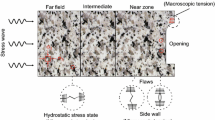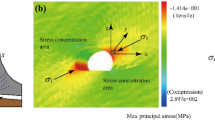Abstract
To investigate the effect of confining pressure on tensile deformation and strength of rocks, a series of confined direct tension tests (CDTT) were conducted on cylindrical granite samples. The results indicate that the deformation/damage process contains the initial micro-crack opening stage and elastic deformation stage. The axial peak strain, radial peak strain, volumetric peak strain, elastic modulus, and Poisson’s ratio all increase with the increase of confining pressure. The strength envelope behaves an interesting “bulge” phenomenon, namely the tensile strength increases and reaches a maximum and then decreases as the confining pressure increases, and the possible reason is suggested that the different levels of confining pressure can cause changes in the magnitude of friction force in the steep dip grain interface and the shear stress in the small inclination grain interface. As the confining pressure goes up, the macrofailure pattern of granite sample under CDTT shows a continuous transition from tensile failure to mixed tensile-shear failure and to shear failure, and further to the compression-shear failure. A new strength criterion, containing a parabolic segment and a linear segment, to consider the “bulge” phenomenon of the strength envelope was proposed. It was examined using the tested data of granite as well as the previous data of Carrara marble, Berea sandstone, and Longmaxi shale, behaving a good fitting effect.

















Similar content being viewed by others
Data availability
Some or all data, models, or code that support the findings of this study are available from the corresponding author upon reasonable request.
Code availability
Not applicable.
Abbreviations
- P c, r :
-
Confining pressure
- σ c :
-
Axial compressive strength
- σ t0 :
-
Uniaxial tensile strength
- CDTT:
-
Confined direct tension test
- F t :
-
Axial tensile stress produced by the test equipment
- E t, μ t :
-
Tensile elastic modulus and tensile Poisson's ratio
- E c, μ c :
-
Compressive elastic modulus and compressive Poisson's ratio
- |ε at|, ε rt, |ε vt|:
-
Tensile axial peak strain, tensile radial peak strain and tensile volumetric peak strain
- ε ac, |ε rc|, ε vc :
-
Compressive axial peak strain, compressive radial peak strain and compressive volumetric peak strain
- a :
-
Axial stress applied to the specimen
- σ t :
-
Axial tensile strength
- σ tu :
-
Ultimate tensile strength
- σ r0 :
-
Radial compressive strength
References
Akazawa T (1943) New test method for evaluating internal stress due to compression of concrete: the splitting tension test. J Jpn Soc Civ Eng 29:777–787
Aliabadian Z, Zhao GF, Russell AR (2019) Failure crack initiation and the tensile strength of transversely isotropic rock using the Brazilian test. Int J Rock Mech Min Sci 122:104073
Bobich JK (2005) Experimental analysis of the extension to shear fracture transition in Berea sandstone. Texas A&M University, College Station (MS thesis)
Boris T, Yves P (2013) Universal criteria for rock brittleness estimation under triaxial compression. Int J Rock Mech Min Sci 59:57–69
Cen DF, Huang D (2017) Direct shear tests of sandstone under constant normal tensile stress condition using a simple auxiliary device. Rock Mech Rock Eng 50(6):1425–1438
Cen DF, Huang D, Song YX, Jiang QH (2020) Direct tensile behavior of limestone and sandstone with bedding planes at different strain rates. Rock Mech Rock Eng 53(6):2643–2651. https://doi.org/10.1007/s00603-020-02070-x
Coviello A, Lagioia R, Nova R (2005) On the measurement of the tensile strength of soft rocks. Rock Mech Rock Eng 38(4):251–273
Du JT, Whittle AJ, Hu LM (2021) Characterization of meso-scale mechanical properties of Longmaxi shale using grid microindentation experiments. J Rock Mech Geotech Eng 13(3):555–567
Fairhurst CE, Hudson JA (1993) Draft ISRM suggested method for the complete stress train curve for the intact rock in uniaxial compression. Int J Rock Mech Min Sci 36(3):279–289
Fatahi H (2014) Simulation of shale mechanical properties in PFC2d and calibration of Them Against Lab results for tensile uni-axial and confined compression tests. SPE Annual Technical Conference and Exhibition, Amsterdam. https://doi.org/10.2118/173464-stu
Fuenkajorn K, Klanphumeesri S (2011) Laboratory determination of direct tensile strength and deformability of intact rocks. Geotech Test J 34(1):1–6
Geng Z, Chen M, Jin Y, Yang S, Yi ZC, Fang X, Du XY (2016) Experimental study of brittleness anisotropy of shale in triaxial compression. J Nat Gas Sci Eng 36:510–518
Goodman RE (1989) Introduction to rock mechanics, 2nd edn. Wiley, New York
Huang D, Li Y (2014) Conversion of strain energy in triaxial unloading tests on marble. Int J Rock Mech Min Sci 66(2):160–168
Huang RQ (2008) Geodynamical process and stability control of high rock slope development. Chin J Rock Mech Eng 27(8):1525–1544
Hudson JA (1969) Tensile strength and the ring test. Int J Rock Mech Min Sci Geomech Abstr 6(1):91–97
Hudson JA, Brown ET, Rummel F (1972) The controlled failure of rock discs and rings loaded in diametral compression. Int J Rock Mech Min Sci Geomech Abstr 9(2):241–249
Kazerani T (2013a) Discontinuum-based model to simulate compressive and tensile failure in sedimentary rock. J Rock Mech Geotech 5(5):378–388
Kazerani T (2013b) Effect of micromechanical parameters of microstructure on compressive and tensile failure process of rock. Int J Rock Mech Min Sci 64:44–55
Kong R, Feng XT, Zhang XW, Yang CX (2018) Study on crack initiation and damage stress in sandstone under true triaxial compression. Int J Rock Mech Min Sci 106:117–123
Lan HX, Chen JH, Macciotta R (2019) Universal confined tensile strength of intact rock. Sci Rep 9:6170. https://doi.org/10.1038/s41598-019-42698-6
Liang Z, Xue R, Xu N, Dong L, Zhang Y (2020) Analysis on microseismic characteristics and stability of the access tunnel in the main powerhouse Shuangjiangkou hydropower station under high in situ stress. Bull Eng Geol Environ 79(6):3231–3244
Liao ZY, Zhu JB, Tang CA (2019) Numerical investigation of rock tensile strength determined by direct tension, Brazilian and three-point bending tests. Int J Rock Mech Min Sci 115:21–32
Li DY, Wong LNY (2012) The Brazilian disc test for rock mechanics applications: review and new insights. Rock Mech Rock Eng 46(2):269–287
Liu JF, Chen L, Wang CP, Man K, Wang L, Wang J, Su R (2014) Characterizing the mechanical tensile behavior of beishan granite with different experimental methods. Int J Rock Mech Min Sci 69(3):50–58
Liu ZB, Zhou HY, Zhang W, Xie SY, Shao JF (2019) A new experimental method for tensile property study of quartz sandstone under confining pressure. Int J Rock Mech Min Sci 123:104091
Ramsey JM, Chester FM (2004) Hybrid fracture and the transition from extension fracture to shear fracture. Nature 428:63–66
Rodriguez E (2005) A Microstructural study of the extension-to-shear fracture transition in Carrara marble. Texas A&M University, College Station (MS thesis)
Rosenbrand E, Kjøller C, Riis JF, Kets F (2015) Different effects of temperature and salinity on permeability reduction by fines migration in Berea sandstone. Geothermics 53:225–235
Vernon RH, Paterson SR (2008) How extensive are subsolidus grain-shape changes in cooling granites? Lithos 105:42–50
Xia KW, Yao W (2015) Dynamic rock tests using split Hopkinson (Kolsky) bar system – A review. J Rock Mech Geotech 7(1):27–59
You MQ (2011) Comparison of the accuracy of some conventional triaxial strength criteria for intact rock. Int J Rock Mech Min Sci 48(5):852–863
Yuan R, Shen B (2017) Numerical modelling of the contact condition of a Brazilian disk test and its influence on the tensile strength of rock. Int J Rock Mech Min Sci 93:54–65
Zeng B, Huang D, Ye SQ, Chen FY (2019) Triaxial extension tests on sandstone using a simple auxiliary apparatus. Int J Rock Mech Min Sci 120:29–40
Funding
This work is supported by the National Natural Science Foundation of China (Nos. 41972297 and 41807279), the Natural Science Foundation of Tianjin Municipality, China (No. 20JCQNJC00980), the Natural Science Foundation of Hebei Province, China (No. E2019202336), and the Supporting program of hundred promising innovative talents in Hebei provincial education office (No. SLRC2019027). Chongqing Postdoctoral Science Foundation (No. cstc2019jcyj-bshX0125) and China Postdoctoral Science Foundation (No. 2019M653343).
Author information
Authors and Affiliations
Corresponding authors
Ethics declarations
Conflict of interest
The authors declare no competing interests.
Rights and permissions
About this article
Cite this article
Huang, D., Liu, Y., Cen, D. et al. Effect of confining pressure on deformation and strength of granite in confined direct tension tests. Bull Eng Geol Environ 81, 110 (2022). https://doi.org/10.1007/s10064-022-02609-y
Received:
Accepted:
Published:
DOI: https://doi.org/10.1007/s10064-022-02609-y




